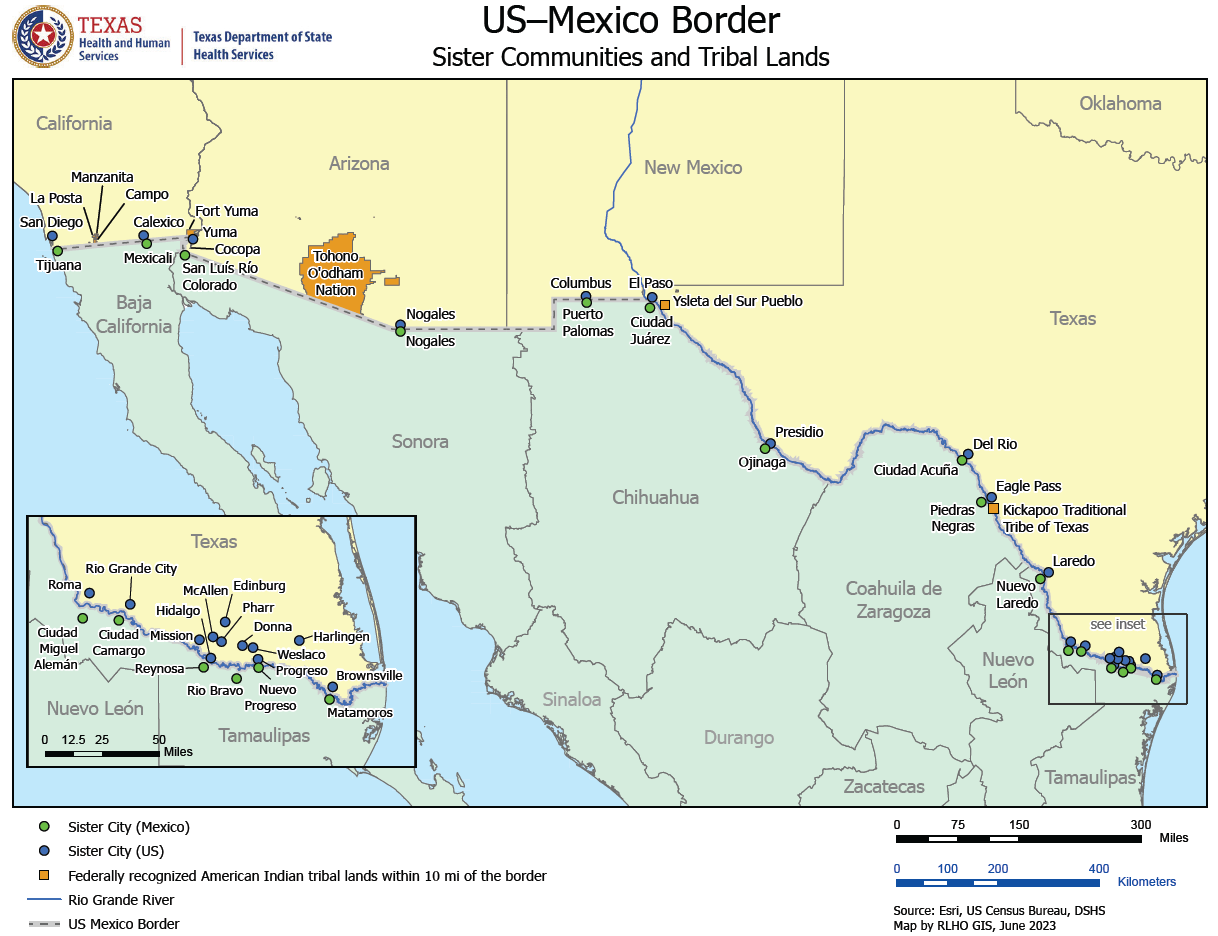The Texas Portion of the U.S.–Mexico Border
The U.S.–Mexico border is 100 kilometers or 62 miles, north and south of the international boundary. This area was defined by the La Paz Agreement in 1983. The Texas border is about half of the U.S.–Mexico border, stretching 1,254 miles.
Four Mexican states share borders with the state of Texas. In order from the southeast coast to the northwest desert:
- Tamaulipas
- Nuevo León
- Coahuila
- Chihuahua
The Texan border includes two federally recognized tribal nations, creating tri-national regions:
- Kickapoo Traditional Tribe of Texas near Eagle Pass
- Ysleta del Sur Pueblo in El Paso
Some binational sister-city communities along the Texas border are:
- Brownsville and Matamoros
- McAllen and Reynosa
- Rio Grande City and cities Miguel Alemán and Camargo
- Laredo and Nuevo Laredo
- Eagle Pass and Piedras Negras
- Del Rio and Ciudad Acuña
- Presidio and Ojinaga
- El Paso and Ciudad Juárez

Population
The Texas border has a population of around three million residents. The population density differs between the frontier, rural, and metropolitan areas. For example, Kenedy County has 0.2 people per square mile while El Paso County has 874 people per square mile.
Demographics
In Texas, compared to the non-border region, the border region has lower infant mortality rates and less heart disease and stroke. Unfortunately, there are higher obesity, diabetes, cervical cancer, and caesarian section delivery rates. There's also more risk for certain contagious diseases such as tuberculosis and Zika. Many people lack access to primary, preventive, and specialty medical care.
The table below compares important factors in border and non-border areas of Texas.
Demographics of Border and Non-Border Areas of Texas
| Factor | Texas Border | Texas Non-border |
|---|---|---|
| Population size | 2.8 million | 27.7 million |
| Population under 18 years of age | 29% | 25% |
| Hispanic ethnicity | 88% | 35% |
| Below poverty level | 24% | 16% |
| Uninsured* | 27% | 17% |
| Do not speak English very well | 30% | 12% |
| At least a high school diploma | 73% | 86% |
| Foreign-Born | 24% | 16% |
Data sources: Population size from Texas Demographic Center Population Estimates Program January 1, 2024. Most recent estimates available as of January 8, 2025.
Remaining data from U.S. Census Bureau, 2018-2022 American Community Survey 5-year Estimates. Percentages computed from files DP05 Demographics and Housing Estimates, S1701 Poverty Status in the Past 12 Months, S2701 Selected Characteristics of Health Insurance Coverage in the United States, S1501 Educational Attainment, B05012 Nativity in the United States, and S0501 Selected Characteristics of the Native and Foreign-Born Populations. Most recent 5-year estimates were available as of April 3, 2024. https://data.census.gov/cedsci/
*Health insurance status calculated for civilian noninstitutionalized population
For more border health data visit the Border Health Data web page.